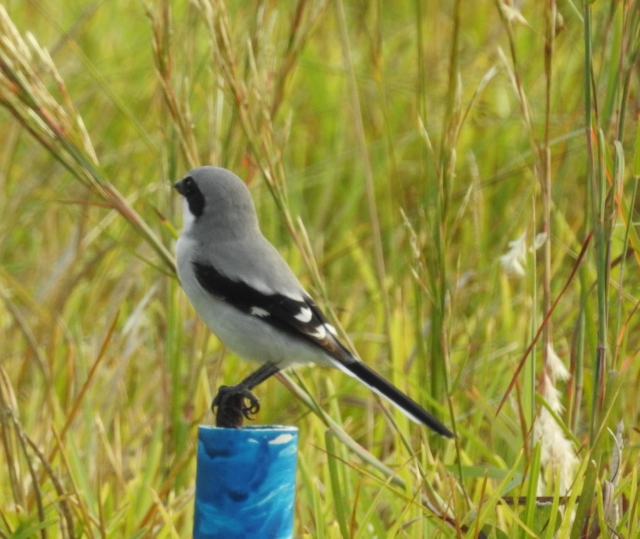
The Loggerhead Shrike AKA “Butcherbird”
The masked white songbird perched on a twig, watching and waiting.
Then, hawk-like, this loggerhead shrike swooped down upon a sparrow, and, with powerful, hooked bill, battered it, piercing its neck. After a few nibbles, it flew off with the limp, dangling corpse, then slid it onto a yucca spine. Eating a bit more, the shrike fluttered to another lookout.
The loggerhead shrike (Lanius ludovicianus) is aptly nicknamed “butcherbird” for its habit of skewering prey upon a convenient projectile—thorn, stick, spear or conveniently-placed chain link or barbed wire—an assembly one calls its “larder” or “pantry.” In fact, its genus name derives from the Latin word for “butcher”. “Loggerhead” describes its large head, while “shrike” comes from an Old English word for “shriek”, indicating its shrieking call.
The loggerhead shrike, similar in size to a mockingbird, has a bluish gray head and back, white underparts, a light gray breast and black mask above its eye and slightly across the top of its black, hooked bill. Projections on the bill’s tomium, or upper edge, called “tomial teeth”, enable it to jab a victim’s spinal cord.
While a loggerhead shrike gulps down tiny insects, it impales larger prey—sizable insects, lizards, frogs, snakes, crabs and other birds—since it lacks talons for grasping. It also wedges prey between limbs. A thorn or spike secures food while it eats.
This shrike may bring down prey even larger than itself—a Northern Cardinal or rodent. High-speed video has shown it grabbing a mouse by its neck, pinching its spinal cord, paralyzing it, then shaking it to break its neck.
A shrike also amasses surplus food to eat during prey shortages. And during breeding season, its “larder” supplies the extra sustenance it needs.
A ranger at Elephant Mountain Wildlife Management Area in Southwest Texas found at least 17 corpses of round-tailed horned lizards on one yucca plant. A shrike, apparently recalling where it stored its victims, may return to a month-old frog carcass.
Impaling noxious prey for a few days—monarch butterflies, eastern narrow-mouthed toads and lubber grasshoppers—allows toxins to dissipate before the birds dine. Also, these shrikes may eat heads and abdomens of lubber grasshoppers but dispose of toxic thoraxes.
With keen eyesight, shrikes scan for prey atop perches, as do falcons, and they sometimes hover. This bird can reportedly spot a flying insect 70 yards away. Occasionally, shrikes hunt on the ground, flashing wing patches, startling victims. They eat more invertebrates, which are readily available, during warm months and in the winter, more vertebrates.
To succeed, a loggerhead shrike requires lookouts—trees, shrubs, cacti, yucca, wires— and a wide swath of low grasses in which to find prey. Meadows with scattered trees and shrubs do nicely. However, these birds also succeed in wooded areas with large gaps and fields with few, or very short shrubs.
Loggerhead shrikes appear on the southern Canadian prairie to Mexico and from California east to Virginia. Though these birds have seriously declined in the Northeast and Midwest, they are doing better in the South. They breed in the Rio Grande Valley where some live year-round and others migrate from cooler areas for the winter.
Since loggerhead shrikes perch on twigs and fences, enthusiasts can easily spot this striking bird. I’ve seen them on sticks in the grove across from the South Padre Island Convention Center and along the bicycle trail in Brownsville.
During courtship, a male loggerhead shrike makes short flight displays—bowing its head, spreading its wings and tail— and entices a prospective mate with a cache of attractive prey. When researchers have tried removing these galleries, males find less success attracting mates. Males may feed females, who, wings aflutter, utter calls like those of begging fledglings. Males guard their mates, preventing extra-pair mating. Rather than fight invaders, males posture and call.
These shrikes mate in early spring and nest from mid-April to late June. Both sexes build the nest, a feather and hair-lined cup supported by twigs and strips of bark, placing it from three to fifty feet high in shrubs and trees, often thorny ones.
While the female incubates the two to nine blue, darkly marked eggs, the male feeds her, often from his cache, which shrikes also may access to nourish chicks. Eggs hatch in from 13-17 days. The birds raise one or two broods yearly. After broods depart, the parents return to their individual hunting territories.
The altricial, or undeveloped, hatchlings require parental care. Chicks fledge in from 17 to 30 days, becoming independent two to four weeks later. Fledglings, in training to become competent shrikes, playact, practicing air chases and pecking at lifeless objects, touching them to branches, as if they would adhere.
The birds create quiet songs of soft trills, buzzes, rasps and often descending notes. Males and females warble their own territorial songs, and the birds make short contact calls to maintain territory and call mates.
Loggerhead shrikes have declined over 80% in the U.S. since the 1960s, according to Breeding Bird Survey. And, in 2014, Birds Watch List named it a “common species in steep decline.” The use of pesticides to kill insects and, of course, habitat loss are likely culprits. We humans have propensities to either whack down vegetation or let it grow wildly, neither of which benefits shrikes.
Several organizations, including Oaks and Prairies Joint Venture and the Loggerhead Shrike Working Group work to help shrikes proliferate in locations like Old Settler’s Park at Palm Valley in Round Rock, Texas, a 570-acre urban area, where 14 pairs have been recently spotted nesting.